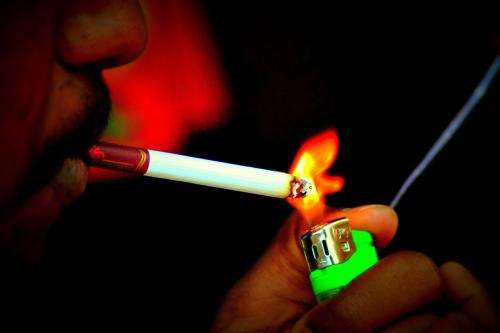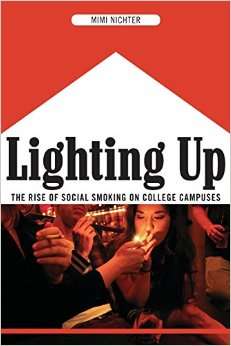Work explores social smoking on college campuses

Many of those who smoke at parties don't actually consider themselves smokers, UA professor Mimi Nichter found, and that calls into question what surveys tell us about smoking in college.
A University of Arizona anthropologist has written a book exploring the culture of smoking on college campuses.
While adult smoking rates have declined dramatically in the U.S. over the past 40 years, young adults ages 18 to 24 continue to smoke more than any other age group, Mimi Nichter writes in "Lighting Up: The Rise of Social Smoking on College Campuses."
In interviews with hundreds of college students conducted over a 10-year period on two college campuses, Nichter set out to discover why young people continue to light up, despite widespread knowledge of the health risks of smoking.
"About 20 percent of smokers initiate smoking in college, and the highest prevalence of smoking is among young adults," said Nichter, a professor in the UA School of Anthropology with joint faculty appointments in public health and family and consumer sciences.
"There are many surveys done continually on smoking, yet there are few studies that look at the social utility and meaning of smoking to young people and how they talk about smoking," Nichter said. "I thought it was important to tell the stories of people who smoke and their experience and feelings about smoking, and how they may fall into addiction."
Nichter looks specifically at the trend of "social smoking" on college campuses, which she also refers to as "weekend smoking" or "party smoking."
While a pack-a-day style of smoking is not common as it once was, social smoking is prevalent at colleges, Nichter said.
These types of smokers tend to smoke occasionally—often while drinking alcohol at parties or other social gatherings. Despite their habit, they usually do not consider themselves smokers, Nichter said. "I smoke but I'm not really a smoker" was a common mantra expressed by those she interviewed. In fact, many students who smoked socially expressed disgust with the smoking habit because of the stigma associated with it.
"If you ask a party smoker on a survey, 'Do you consider yourself a smoker?' they'll say no," Nichter said. "Over 50 percent of people who do smoke at some level don't consider themselves smokers."

This finding calls into question some of what we know from survey data about smoking on college campuses, Nichter said.
"I think that survey research is very important, but when we consider that people don't report that they are smoking, it becomes all the more important to understand why people smoke and the social contexts in which it is considered appropriate," she said.
Some of the most common reasons students start to smoke in college are what one might expect, Nichter found in her interviews. They say it will help them meet people, fit in with a group or make them look more relaxed and laid back.
Most of the social smokers Nichter interviewed dismissed the behavior as "no big deal," with some suggesting that alcohol and cigarettes are a combination as natural as milk and cookies or peanut butter and jelly.
The problem with that thinking, Nichter says, is that smoking can be addictive even at very low levels.
"What I describe is how there can be a slippery slope into addiction," Nichter said. "Most people who smoke socially have no desire to become a 'real smoker'—in fact, they find it completely disgusting to be addicted to cigarettes, and yet it does happen to some people."
Many of the students Nichter interviewed indicated that they planned to quit smoking altogether when they graduated and entered the "real world." Yet, when she spoke with students again in their senior year, many no longer were interested in quitting and thought they would do so when they settled down, were in a serious relationship or decided to have a family.
Nichter speculates that the continuation of smoking from college into adulthood may have something to do with the fact that young adult lives are more unsettled now than they once were.
With young adults taking longer to reach major life milestones—such as getting married, having a family or settling into a stable job—they may use smoking as a way to cope with uncertainty, Nichter said.
"College graduates have very uncertain trajectories now," she said. "All these milestones that we used to have are now pushed forward, so there's no predictability. Over a third of those in their 20s move to a new residence each year, and many college grads go through an average of seven jobs during this decade of life. For those who have learned to smoke socially as a way to make friends, or for self-medication or coping purposes, they may continue to smoke as they move through these unstable years."
In an effort to curb smoking on college campuses, many universities, including the UA, have implemented smoking bans. The UA became a tobacco-free campus last year.
As colleges nationwide work to address smoking among students, Nichter suggests that a two-pronged approach, which considers alcohol and tobacco use simultaneously, could be beneficial.
"I want people to understand that smoking and drinking are a consumption event that need to be addressed together," Nichter said.
"There is a lot of literature that talks about the relationship between smoking and drinking, and if we look on campuses, we know that there's a lot of work on alcohol reduction, and for good reason," she said. "I think there's also some neglect of the reality that these two substances go hand-in-hand. So when we're looking to the future, we really need to think about co-substance use. We need to acknowledge that and educate students about it together, in context not in isolation."
Nichter has been involved in tobacco-use research for more than 15 years. In addition to her work with college students, she also has been involved in smoking cessation efforts abroad. She currently is the principal investigator on a project funded by Global Bridges at the Mayo Clinic that focuses on smoking in Istanbul, Turkey. She also served as a co-principal investigator from 2002-13 on two National Institutes of Health Fogarty-funded projects developing capacity for tobacco cessation in India and Indonesia, where smoking rates are especially high.
Nichter's book, "Lighting Up: The Rise of Social Smoking on College Campuses," is intended for general audiences and is available on Amazon.















